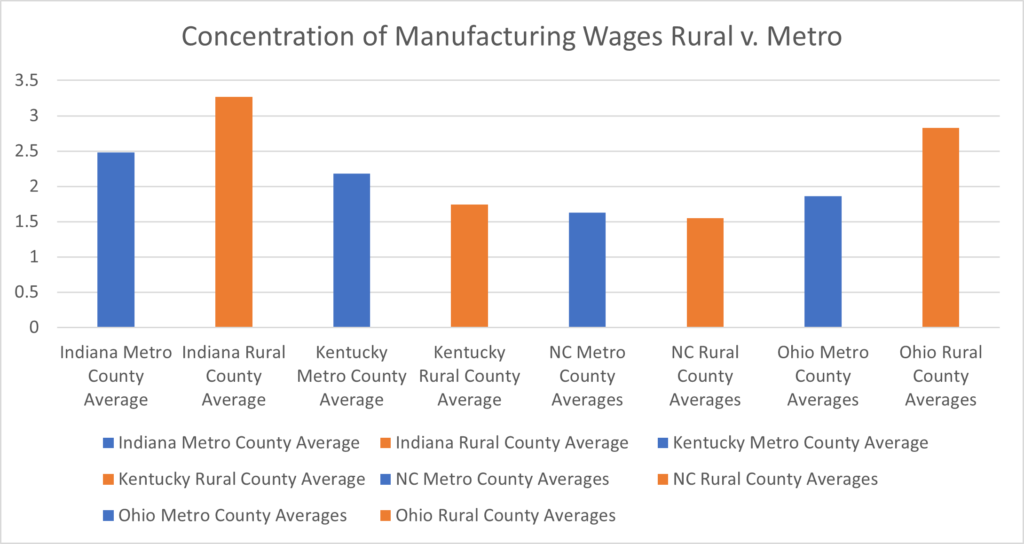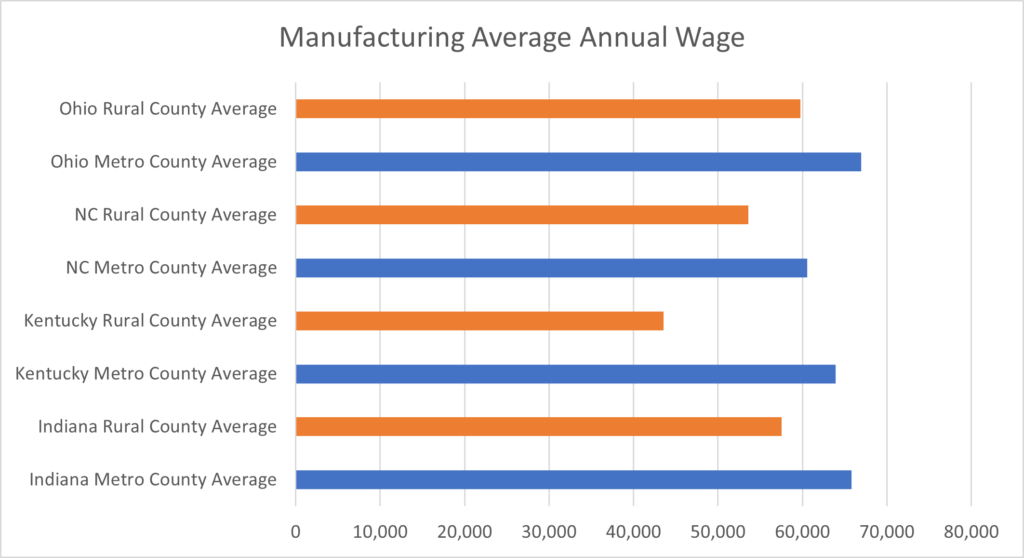Rural communities present substantial economic opportunities. Manufacturers in the United States account for 11.39% of the total output in the economy, employing 8.51% of the workforce.[i] Total output from manufacturing was $2,334.60 billion in 2018.[ii] In addition, there were an average of 12.8 million manufacturing employees in the United States in 2018, with an average annual compensation of $84,832.13 in 2017.[iii] The percentage of the American economy manufacturing makes up has been declining steadily since the 1950s but it remains a substantial component of the nation’s economy with its high-wage jobs.
Whether it is the attraction of a skilled and ready workforce, fewer labor unions, and flat, ready land primed for development, rural communities are often the choice for manufacturing corporate site location projects. The table below illustrates that rural counties in Ohio, North Carolina, Indiana and Kentucky all have a higher concentration of manufacturing workforce wages than their metro counterparts. All these markets are strong manufacturing centers as they are above a location quotient of one. Measures of location quotients are a statistical tool to indicate whether a particular industry cluster is strong or weak in a region. Based upon national averages, a location quotient of one defines the region as meeting the national average for that industry. A location quotient below 1 indicates the region does not have a particular industry cluster strength in that market and above 1 illustrates the industry’s relative strength.

Source: U.S. Bureau of Labor Statistics, Quarterly Census of Employment and Wages
Rural markets in Indiana and Ohio far outweigh their urban counterparts with a concentration of manufacturing jobs while the metro regions in Kentucky and North Carolina edged out their state rural counterparts.
Rural communities’ costs of doing business are lower than their urban counterparts. The largest cost for every company is labor. Paying workers, unless it is a data center or other energy-intensive, capital-intensive business, will be the largest cost facing any company. Regions with competitive wage rates are highly attractive for corporate site location projects. As the table below illustrates, rural counties in Indiana, Kentucky, North Carolina, and Ohio pay manufacturing workers a lower wage compared to their metro-urban counterparts in the same states. The same factor in an urban setting costs more to operate which quickly adds up to millions of dollars in costs. From a public policy standpoint, all these manufacturing jobs in metro and rural communities pay far above the average wage in the state—these are still high-wage jobs communities should continue to chase. From a wage benchmarking standpoint between these four states, Kentucky leads the race with the lowest average manufacturing worker wages, followed by North Carolina, Indiana then Ohio. However, all these wages remain highly competitive.

Source: U.S. Bureau of Labor Statistics, Quarterly Census of Employment and Wages
Workforce costs are not the only factor impacting rural communities’ lower cost of doing business. Lower real estate costs are another important factor making rural markets attractive for corporate site location projects. First, real estate is all driven by local factors impacting the site in question. So, generalizations can be challenging but the laws of supply and demand and the rapid growth of urban and suburban markets have driven up prices in these urban markets. Second, many urban sites are complex compared to rural greenfield sites. Urban sites in many cases involve a reuse of land that has benefited from an infrastructure standpoint but may have environmental issues as well as being in a struggling neighborhood with residents who may or may not wish development. Rural America wins global manufacturing corporate site location projects based upon a competitive cost of doing business for labor and other prime company expenses.
[i] https://www.nam.org/state-manufacturing-data/2019-united-states-manufacturing-facts/#:~:text=Manufacturers%20in%20the%20United%20States,was%20%242%2C334.60%20billion%20in%202318.
[ii] Ibid.
[iii] Ibid.